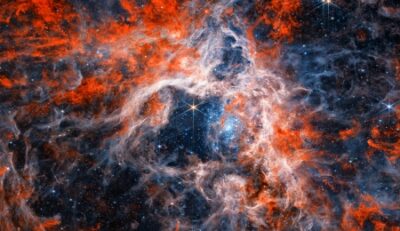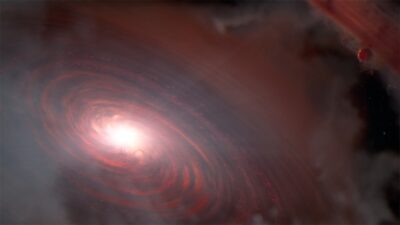A misty mystery from the James Webb Telescope travel across space to our scientists every day. We investigated one of the latest mysteries in our most recent blog. In that article, we began the story of how the telescope discovered water deep in outer space.
Indeed, this article should be considered Part Two of our blog series about the James Webb Telescope detecting water in outer space. Please read or review the previous blog, which establishes how the deep space telescope found water in a strange planet-forming environment.
The Misty Mystery of Water Vapor in Space

By the Time Most Read This Blog, We Will Have Passed Labor Day Holiday And The Official End of Summer Activities. But Star-Gazing is a Fine Activity Any Time of Year.
Most of you are familiar with the achievements of the James Webb Telescope and its deep-space voyage. Let’s set the scene of a recent image that proved water can exist in space.
As referenced in our previous article, we know that PDS 70 is a K-type star. Compared to our star, Sol, it is only a little older and cooler. Scientists estimate it to be about 5.4 million years old and three quarters as big as our sun. Additionally, it is in a dusty swirling, gaseous area of the cosmos, known as a planet-forming disk.
In the Webb’s images a distinct and unexpected mist made a ghostly appearance. It wasn’t carbon dioxide, methane or stardust. The Webb’s instruments proved it was water vapor.
The conditions area around PDS-70 are very active. The space is massively involved in creating planets and stars. And that is why the presence of water vapor shocked the scientists.
An Abnormal Condition for Water
You see, scientists understand that “Over time, the gas and dust content of planet forming disks declines.” Then, due to previous studies of planet-forming disks, researchers believed there were two possibilities.
- On the one hand the scientists believed the central star’s radiation and winds would blow out water.
- On the other hand, the dust grows into larger space objects. There’s no room even for water vapor. These objects grow larger to make up planets.
How the Webb Disproves Previous Water Theories

Note the Misty Quality of This Rendition. It is Not Methane Or Carbon Dioxide. It’s Just Plain Water.
In summary, the researchers thought the formation of rocky planets always happened in a dry environment. They deduced that water came later.
But the images from Webb proved them wrong. With its misty images and water data, Webb showed them that planet-forming areas could have water available from the very beginning of a planet’s life.
Misty Mystery of the Forming Planets: Solved!
By the way, let ER Optics clear up any mystery about the rocky elements that become space objects and then planets. Various silicates make up the matter that builds planets.
- If you remember your basic chemistry, “The silicates are the largest, the most interesting and the most complicated class of minerals than any other minerals.”
- And you might have guessed that “Approximately 30% of all minerals are silicates and some geologists estimate that 90% of the Earth’s crust is made up of silicates, SiO44-based material.”
- And then, we conclude that “oxygen and silicon are the two most abundant elements in the earth’s crust.”
At ER Optics, we grow silicon crystals. So, you can imagine that we are fascinated by the Webb Telescope’s discoveries about planet forming.
Astronomers Further Investigate the Misty Mystery of Planet Formation
Scientists have not yet found any planets forming in the spiraling activity of the twin fields surrounding the PDS-70 star. But the conditions are ripe. The spiraling area has water, and silicates.
Then we can make assumptions. Rens Waters of Radboud University in the Netherlands stated, “We find a relatively high amount of small dust grains. Combined with our detection of water vapor, the inner disk is a very exciting place.” He and other researchers agree that new planets forming there would have water available to them from their birth.
So, Where Did the Space Water Come From?

Another Misty Mystery: The Tanantula Nebula. The Webb Telescope Found No Water Here, but plenty of Stardust Ebbs and Flows.
The curious scientists consider two different paths from which water might have been caught within the churning spiral around PDS-70.
- The misty mystery could have happened when hydrogen and oxygen atoms combined, forming water vapor within the moment of our detection.
- Alternatively, we might think that “ice-coated dust particles are being transported from the cool outer disk to the hot inner disk. There “the ice sublimates and turns into vapor.” However, there is a problem with this theory. There is a great distance between the inner and outer ring, controlled by the two giant planets in the system.
Another Conundrum in the Mystery
There is a deeper mystery, no matter which of the two theories we accept. We have to ask “how water could survive so close to the star…” You see, normally ultraviolet light should bust apart the water molecules. Scientists speculate that the tiny silicate particles of dust actually form shields around the water molecules. Then, we could explain how the water survives.
Soon, the researchers will use the Webb’s NIRCam and the NIRspec to prove or disprove this deduction. But you must admit that it sounds very likely.
Going Beyond the Misty Mystery
In conclusion, we can only know one truth that is not theory but fact: “The James Webb Space Telescope is the world’s premier space science observatory.” We must add, “Webb is solving mysteries in our solar system, looking beyond to distant worlds around other stars…”
As the Webb continues its deep space voyage, ER Optics smiles at the certainty that it could not probe the mysteries of the universe without silicon crystals. They are the power behind the Webb Telescope’s instruments and navigation.

ER Optics Wishes You a Happy Labor Day. We Smile as We Bid Farewell to Summer and Turn to Cooler Fall Days and Cozy Nights.


